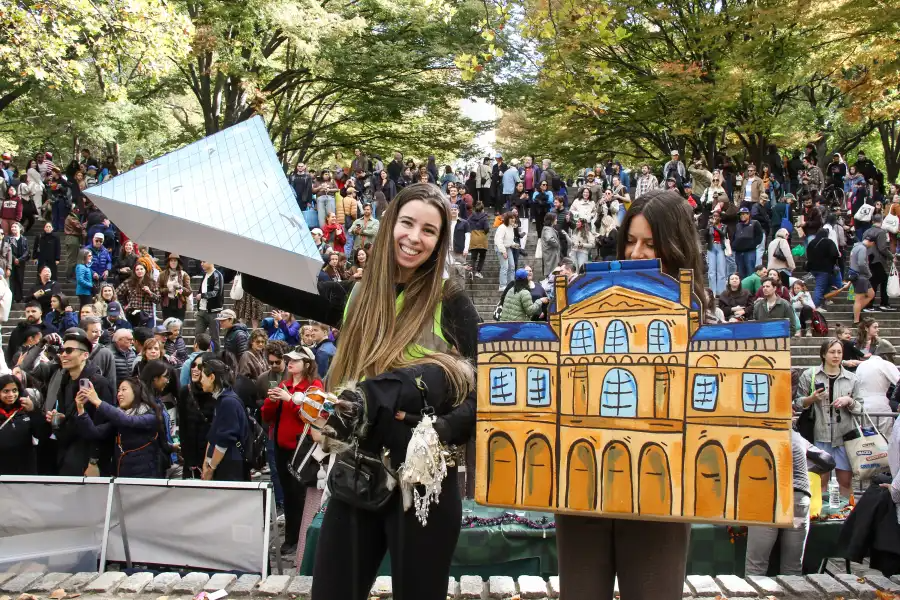Building of the Day: 199-211 Malcolm X Boulevard
Brooklyn, one building at a time. Name: Storefront and flats buildings Address: 199-211 Malcolm X Boulevard Cross Streets: Jefferson and Putnam Avenues Neighborhood: Bedford Stuyvesant/Stuyvesant Heights North Year Built: 1884-1885 Architectural Style: Queen Anne Architect: Unknown, perhaps Amzi Hill & Son Landmarked: No The story: The north/south blocks of the eastern side of Bedford Stuyvesant…

Brooklyn, one building at a time.
Name: Storefront and flats buildings
Address: 199-211 Malcolm X Boulevard
Cross Streets: Jefferson and Putnam Avenues
Neighborhood: Bedford Stuyvesant/Stuyvesant Heights North
Year Built: 1884-1885
Architectural Style: Queen Anne
Architect: Unknown, perhaps Amzi Hill & Son
Landmarked: No
The story: The north/south blocks of the eastern side of Bedford Stuyvesant offered their original developers the opportunity to create fine commercial blocks, building mixed-use buildings with elegant storefronts below and apartments above. The architects of these buildings were the same men who designed the residential blocks surrounding them, the result of which is a fine collection of buildings that perfectly blend into the neighborhood, blurring the lines between residential and commercial.
These avenues are the lifeblood of a community. Bakery, butcher, milk, groceries, dry goods, hardware, stationery, millinery, shoe shops and drug stores; all kinds of stores needed in a thriving community were here. Very often the proprietor and his family lived above the shop, and the rest of the flats were rented out. The flats gave working people the opportunity to live in neighborhoods they might not have been able to afford otherwise, and in general, life above a shop was respectable and good.
Up until the end of the 20th century, this street was called Reid Avenue. You can still find oldtimers who still refer to that name, not Malcolm X Boulevard. This group, 199-211 Reid Avenue was probably built around 1884-1885. That was the first reference I found, and the article mentioned that the building was about to be built. I was not able to find the developer or the architect, but I suspect that it might be Amzi Hill, the architect who designed hundreds of buildings in this area. The features and details, especially the oriels and trim are similar to documented work he did elsewhere in Bedford Stuyvesant.
Most of the mixed use buildings on this avenue are four stories in height, these are only three, but have generously high ceilings in the flats above, and look to be a bit more elegant and upscale than the norm. A perusal of newspaper accounts show all kinds of people living here over the years, including doctors, teachers, chauffeurs and grocers. The buildings are wide, 26 feet by 60 feet, and were called “double sized flats” with four apartments in each building.
The chauffeur had to be the most interesting character in the group. His name was William Doane. He lived at 209 Reid, in the early 20th century. In 1905 he was arrested for driving into the side of an apartment building in Manhattan. He had taken the turn too sharply. At the time, he was the chauffeur for a Mme. DeTiers, who was some kind of stunt driver/performer at Madison Square Garden. She was well known for “looping the gap,” whatever that was. Perhaps Mr. Doane should have learned that stunt. Five years later, Doane had another turn of bad luck with an automobile. He was cranking the handle of the car, and it slipped, smacking him in the face. He suffered a fractured nose and lacerations to his cheek and tongue. He had to be taken to the hospital, where he was looked at, and then sent home.
In 1912, 201 Reid had a candy store on the ground floor. It caught fire when a child was playing with fire in the back of the store. The fire was put out before too much damage was done. Much later, in 1949, the same storefront was home to the Mutual Sales Syndicate Company, which sold appliances like refrigerators, radios and televisions. This was a black owned business, “Negro” at the time, and the owner, Duke Pepper, had the foresight to put an ad in the Brooklyn Age newspaper advertising his products. His sales soared, and many Negro patrons wrote to the paper thanking them for running the ad. The paper did a story on it. That’s how far we’ve come.
Unfortunately, we’ve also come far enough to see what happens when there are no restrictions on infill housing. The symmetry of this elegant row was ruined when a Fedders house was built at 207, after the building had been demolished, probably after a fire. The house was built with an even more annoying setback, totally taking it off the street grid. This building was built in 2005. Although the storefronts in this row were long ago altered, most beyond recognition, this was still a fine row, with lots of remaining detail. There need to be rules regarding this sort of thing. Really. GMAP








What's Your Take? Leave a Comment